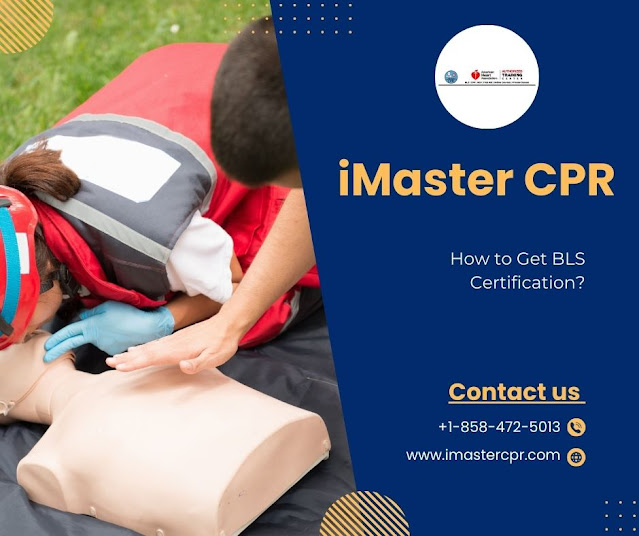How to Get BLS Certification?
Basic Life Support (BLS) certification is a crucial credential for healthcare providers, first responders, and individuals seeking to learn essential life-saving skills. This certification equips you with the knowledge and hands-on techniques needed to perform CPR, use an AED, and manage other medical emergencies effectively. If you're looking to obtain BLS certification, this guide outlines the steps involved, with a focus on accessing training options like BLS Certification San Diego programs, including courses offered by iMaster CPR.
Step 1: Understand What BLS Certification Covers
BLS certification focuses on emergency care techniques for medical and cardiac situations. The course typically includes:
CPR (Cardiopulmonary Resuscitation): Techniques for adults, children, and infants.
AED (Automated External Defibrillator): How to operate an AED effectively.
Airway Management: Clearing obstructions and maintaining open airways.
Team Dynamics: Working efficiently in a healthcare or team-based setting.
Understanding the scope of the certification helps you prepare for the course and ensures you're ready to apply the knowledge in real-world emergencies.
Step 2: Choose the Right Training Provider
When pursuing BLS certification, it’s essential to select a trusted and accredited training provider. Look for certifications recognized by reputable organizations like the American Heart Association (AHA) or the American Red Cross.
For those in Southern California, BLS Certification programs offer excellent options. Providers like iMaster CPR ensure high-quality training, combining expert instruction with hands-on practice.
Factors to consider when choosing a provider include:
Accreditation and certification validity.
Availability of in-person, online, or blended learning options.
Flexibility of class schedules.
Accessibility of training locations.
Step 3: Register for the Course
Once you’ve identified a training provider, the next step is to register for the course. Most providers, including us, offer online registration. You can browse their course schedule to select a time and format that fits your needs.
If you're in the San Diego area, programs like BLS Certification often provide multiple options, from weekday classes to weekend sessions. Online and blended formats are also available for those with busy schedules.
Step 4: Complete the Theoretical Component
BLS certification courses typically start with a theoretical component. For online or blended learning formats, this may involve watching instructional videos, completing quizzes, and studying course materials on a learning platform. Topics covered include:
Recognizing cardiac arrest and other emergencies.
Performing high-quality chest compressions and rescue breaths.
Proper use of an AED.
Take your time to absorb the material and review key concepts to ensure a strong understanding before moving on to the practical portion.
Step 5: Participate in Hands-On Training
The practical component is where you’ll apply what you’ve learned. This hands-on training is a critical part of obtaining BLS certification, as it allows you to practice skills like chest compressions, rescue breaths, and AED operation under the guidance of certified instructors.
For those taking Basic Life Support Certification courses, local training facilities provide state-of-the-art equipment and experienced instructors to help you gain confidence in your abilities. We, for example, offers interactive, in-person sessions that emphasize real-world application.
Step 6: Pass the Assessment
To earn your certification, you’ll need to pass an assessment that typically includes:
Written Exam: Testing your knowledge of theoretical concepts.
Skills Test: Demonstrating practical techniques, such as performing CPR and using an AED.
The instructor will guide you through the process, offering feedback and ensuring you’re well-prepared to succeed.
Step 7: Receive Your Certification
Upon completing the course and passing the assessment, you’ll receive your BLS certification. Many providers, including iMaster CPR, issue digital certificates, which are convenient and easy to share with employers. Ensure that your certification is valid for the required duration—usually two years—and keep track of the renewal date.
Why Choose BLS Certification San Diego Programs?
San Diego offers a variety of excellent BLS certification options, making it easy to find a program that meets your needs. Some of the benefits include:
Experienced Instructors: Skilled professionals who provide personalized guidance.
Convenient Locations: Accessible training centers in the San Diego area.
Flexible Learning Options: In-person, online, and blended formats to suit different schedules.
Organizations like iMaster CPR stand out by offering comprehensive training, high-quality materials, and American Heart Association-approved certifications. Their dedication to ensuring learners feel confident and prepared makes them a top choice for BLS certification in San Diego.
Step 8: Renew Your Certification
BLS certification is typically valid for two years. To maintain your credentials, you’ll need to complete a renewal course before your certification expires. Renewal courses are often shorter than initial training, focusing on refreshing your skills and updating you on any changes to CPR guidelines or techniques.
Final Thoughts
Obtaining BLS certification is a valuable step for anyone who wants to be prepared to handle medical emergencies. Whether you’re a healthcare professional, first responder, or someone who simply wants to learn life-saving skills, the process is straightforward and accessible.
For those in California, BLS Certification San Diego programs offer top-tier training options. With providers like iMaster CPR, you can expect high-quality instruction, flexible learning formats, and recognized certification. Take the first step today, and equip yourself with the knowledge and skills needed to save lives.



Comments
Post a Comment